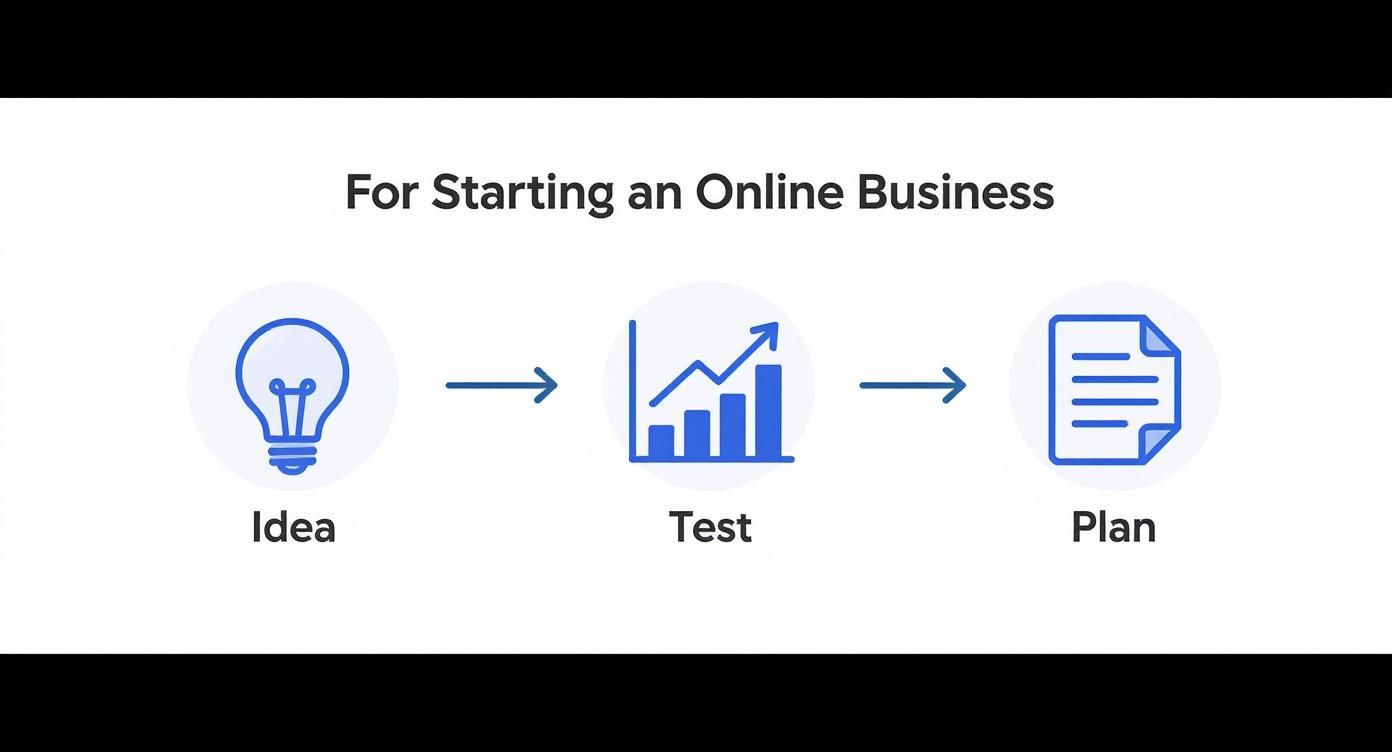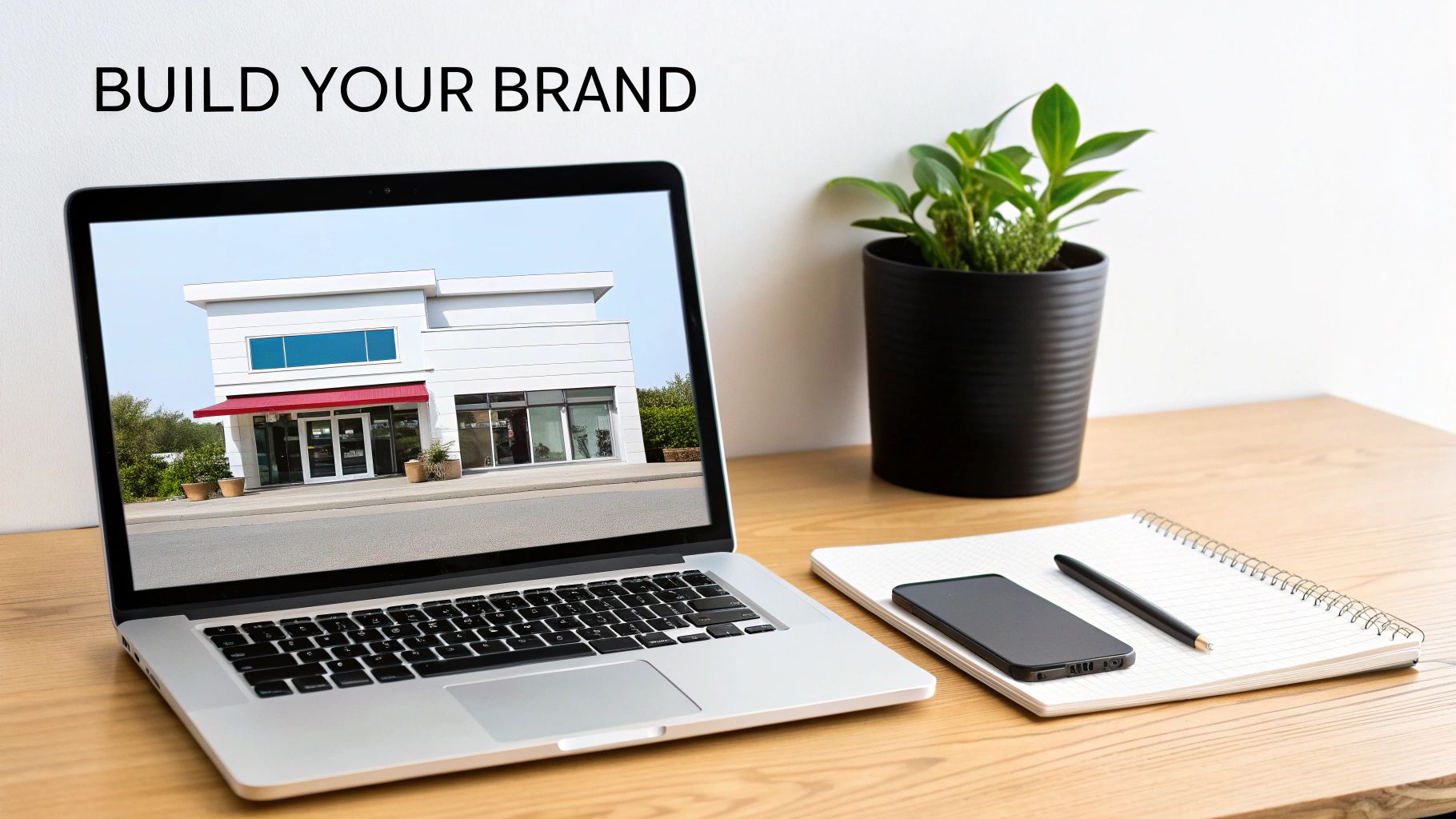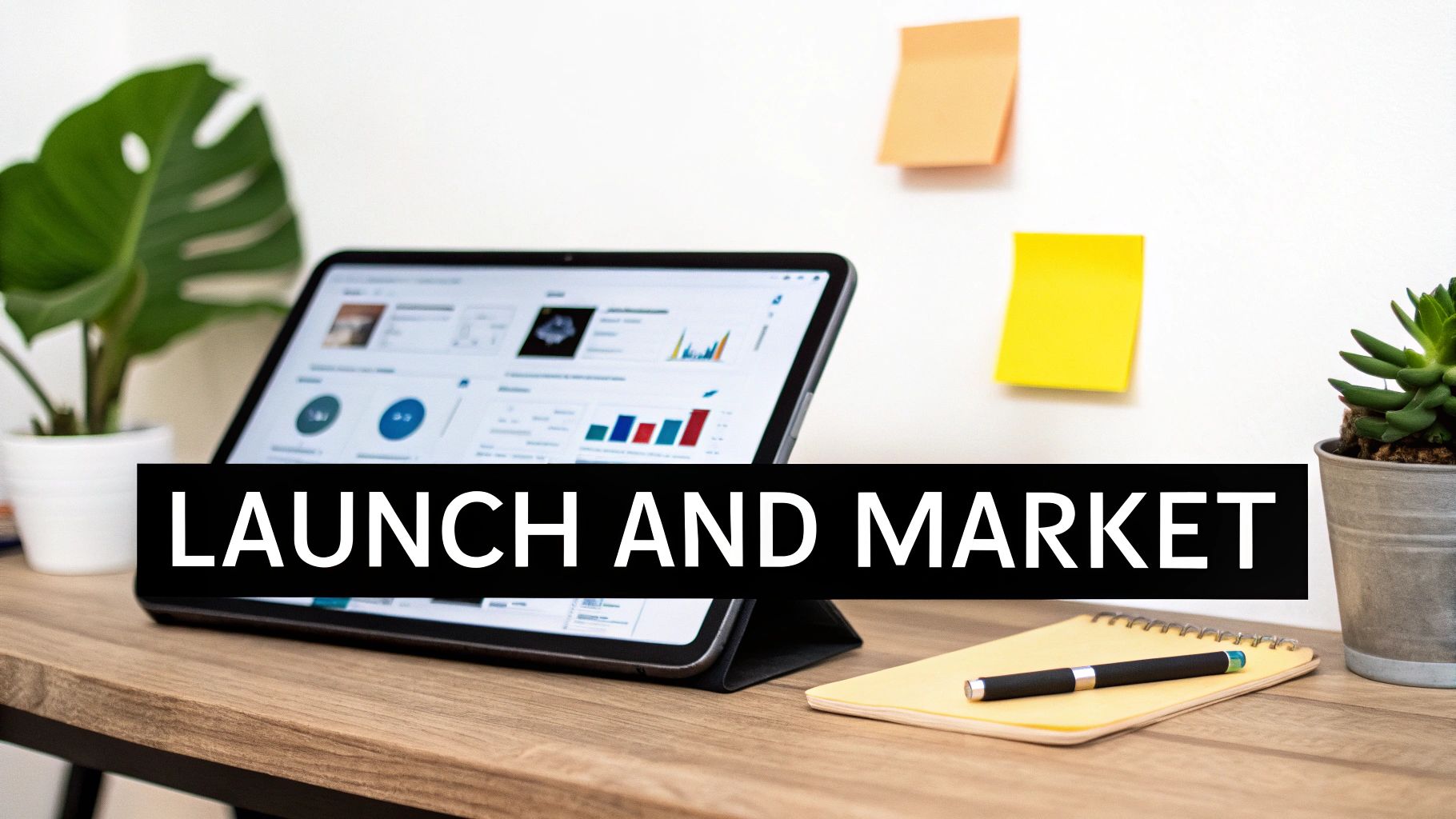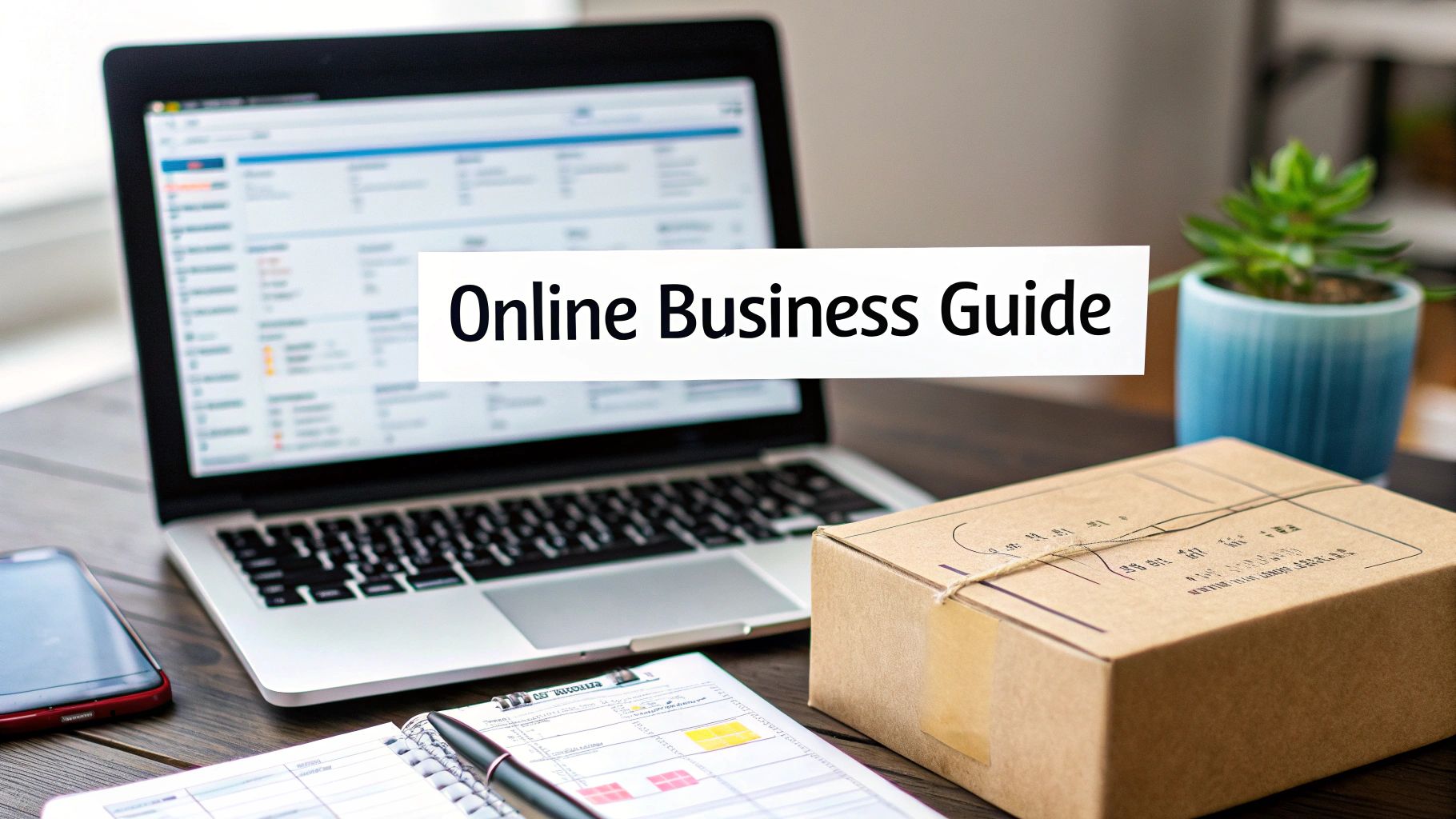Australia
Starting an online business really boils down to four key moves: finding a profitable idea, checking if real customers want it, sketching out a simple plan, and sorting out the basic legal stuff. Getting this foundation right is what separates a successful business from an expensive hobby. It ensures you're building on solid ground before you even think about a website.
Finding Your Footing in the Digital Marketplace
Before a single dollar gets spent on web design or products, the most important work has to happen. This is where you move past chasing trends and start digging into the strategic groundwork that makes a business last. It’s all about finding an idea that not only gets you excited but also solves a real problem for a specific group of people.
The goal isn't just to have an idea; it's to have a validated one. Validation means getting confirmation that people aren't just interested—they're actually willing to pay for what you're offering. This one step de-risks your entire venture, saving you a massive amount of time, money, and heartache down the road.
Uncovering and Testing Your Niche
A brilliant business idea often lives at the intersection of your passion, your skills, and what the market actually needs. Don’t just think about what you can sell; think about what problems you can solve. Are you a fitness buff who can make home workouts less intimidating? Or a tech whiz who can help small businesses with their IT headaches?
Start by brainstorming problems you've personally faced or seen friends and family struggle with. Those little frustrations are often shared by a much bigger audience.
Once you’ve got a concept, it’s time for a reality check. Here are a few practical ways to test the waters:
- Keyword Research: Use free tools to see if people are actively searching online for solutions related to your idea. A high search volume is a great sign that demand already exists.
- Social Media Polls: Casually poll your network on platforms like Instagram or LinkedIn. A simple "Would you use a service that does X?" can be incredibly revealing.
- Competitor Analysis: See who’s already playing in your chosen field. Their existence is proof of a market, and their weaknesses are your opportunities.
This visual guide breaks down the fundamental process into three clear stages.

As the infographic shows, a solid plan has to follow your idea and testing phases to create a business that's built to last.
And speaking of opportunities, the Australian e-commerce market is a fantastic place to start. With a total volume of roughly US$89.4 billion and retail e-commerce hitting US$46.2 billion, the potential is undeniable. Categories like fashion ($7.64 billion) and DIY & hardware ($4.96 billion) prove that Aussie consumers are comfortable buying a huge range of products online.
Crafting Your One-Page Business Plan
Forget the 50-page document that will just gather dust. A modern business plan is a lean, one-page roadmap that clarifies your vision and keeps you focused. Think of it as a living document that will evolve as you learn and grow.
Your plan should concisely answer these core questions:
- What problem do you solve? (Your Mission)
- Who is your ideal customer? (Your Target Audience)
- How will you reach them? (Your Marketing Channels)
- What makes you different? (Your Unique Value Proposition)
- How will you make money? (Your Revenue Streams)
Before you dive in, it’s worth using a quick checklist to make sure your idea has legs. A structured approach here can save you from pursuing a concept that's doomed from the start.
Online Business Idea Validation Checklist
Use this checklist to quickly assess if your business idea has real potential before you commit.
| Validation Step | Key Question to Answer | Simple Action |
|---|---|---|
| Problem Check | Does this solve a real, recurring problem for someone? | Ask 10 people in your target audience if they face this issue. |
| Market Demand | Are people actively searching for a solution to this problem? | Use a free keyword tool to check search volume for related terms. |
| Willingness to Pay | Have people paid for similar solutions in the past? | Research competitor pricing and look at their customer reviews. |
| Audience Access | Do you know where to find and connect with your ideal customer? | Identify 3 online communities or social media groups where they hang out. |
| Uniqueness | What makes your solution better or different from what's out there? | List 2-3 key features or benefits your competitors don't offer. |
This simple exercise forces you to think critically and gather evidence, turning a gut feeling into a data-informed decision.
To really solidify your vision, consider using a great e-commerce business plan template. This process prepares you for the inevitable pivots and changes that come with building a business. In fact, learning to manage those shifts is a skill in itself, which you can read more about in our guide on https://blogs.digitalhubkey.com/organizational-change-management.
Handling Australian Business Legalities and Finances

Let’s be honest, tackling the legal and financial side of a new online business can feel like a huge hurdle. It’s the part that most of us dread, but getting these fundamentals right from the very start is your best defence against future headaches.
Think of it less as boring paperwork and more as building a solid, compliant foundation. These early decisions directly impact everything from your personal liability to your tax obligations, so you can focus on growth instead of scrambling to fix problems down the track.
Choosing Your Business Structure
One of the first big forks in the road for any Aussie entrepreneur is picking a business structure. This choice dictates your legal responsibilities and how you’ll handle your tax. For most new online ventures, the decision usually comes down to two main options.
A sole trader setup is the simplest and most common starting point. You are the business. This means you trade under your own name (or a registered business name) and are personally responsible for all its debts. All income is simply treated as your personal income. It's straightforward and cheap to set up.
A proprietary limited (Pty Ltd) company, on the other hand, is a completely separate legal entity. This structure puts a wall between your personal assets and the business, offering you far more protection if things go wrong. The trade-off? It comes with higher setup costs and more complex reporting requirements.
Key Takeaway: For most people just starting out, the sole trader path is the way to go. It's simple and low-cost. You can always change your structure and register as a company later as your business grows and your revenue justifies the extra complexity.
Getting Your ABN and Understanding GST
No matter which structure you choose, you’ll need an Australian Business Number (ABN). This unique 11-digit number is your business's official identifier for the government and other businesses. It’s essential for sending invoices, claiming tax credits, and looking legitimate to your customers. Applying for one is completely free through the Australian Business Register.
Next up is the Goods and Services Tax (GST). There's a common myth that you need to register for GST the moment you start, but that's not the case.
- When you must register: In Australia, you're only legally required to register for GST once your annual business turnover hits (or is expected to hit) $75,000.
- Registering early (voluntarily): You can choose to register before hitting that threshold. The main upside is that you can claim GST credits back on your business purchases, which can be a real help if you have significant startup costs.
- The catch: Once you're registered, you have to charge GST on all your sales and lodge regular Business Activity Statements (BAS) with the ATO.
For most new online businesses, it makes sense to wait until you're getting close to that $75,000 threshold before you register. It keeps things much simpler in the early days.
Separating Finances and Keeping Clean Records
Even as a sole trader, mixing your business and personal finances is a recipe for disaster. As soon as you have your ABN, open a dedicated business bank account. Trust me, this one simple step will make tracking your income and expenses infinitely easier and keep your bookkeeping clean.
Good record-keeping isn't just a chore for tax time; it gives you a crystal-clear picture of your business's financial health. Use simple accounting software or even just a well-organised spreadsheet to track every dollar coming in and going out. Building this habit from day one will save you immense stress and help you make much smarter financial decisions.
Finally, since your entire business operates online, protecting your financial data is non-negotiable. To get up to speed on this, check out our guide covering the essentials of cybersecurity for small businesses. Keeping your money and your data safe is a cornerstone of any sustainable digital venture.
Building Your Digital Storefront and Brand
Your website is far more than just a gallery for your products. Think of it as your virtual headquarters, your 24/7 salesperson, and the very heart of your brand’s experience. This is the point where all the planning becomes real, where we start building an online presence that doesn’t just look professional but is properly engineered to turn casual visitors into loyal customers.
Getting this right involves two crucial, intertwined steps: picking the right technology to build on, and then layering on a brand identity that truly connects with your target audience. The platform you choose will shape your day-to-day operations, while your branding dictates how customers see and feel about your business.
Choosing the Right E-commerce Platform
For any new Aussie business, wading through the e-commerce platform options can feel a bit overwhelming. The right choice really comes down to your technical comfort level, budget, and where you see your business heading in the long run.
Let’s break down the main contenders.
-
Shopify: This is the go-to for most beginners, and for good reason. It’s an all-in-one solution that handles hosting, security, and payment processing for you. Its drag-and-drop interface means you can get a beautiful, functional store up and running without ever looking at a line of code.
-
WooCommerce: If you've ever used WordPress, WooCommerce is a powerful and incredibly flexible plugin that turns your site into a fully-fledged online store. It offers almost endless customisation, but it does require more hands-on management. You'll need to sort out your own web hosting and security.
-
BigCommerce: As a direct competitor to Shopify, BigCommerce is a robust platform known for its huge list of built-in features, which can cut down on the need for paid apps. It’s highly scalable, making it a strong option if you’re planning for rapid growth right from the start.
For most people just starting an online business, Shopify offers the smoothest and fastest path to launch. It takes care of the technical headaches, letting you focus on what really matters: your products and your marketing.
Here’s a look at the Shopify dashboard, which gives you a central command centre for everything from product management to sales analytics.
As you can see, the layout is clean and intuitive, designed to make managing your online store straightforward, even if you’ve never done it before.
Expert Tip: Before you commit, make the most of the free trials all these platforms offer. Spend a couple of days building a test store. This hands-on experience is the single best way to figure out which interface feels right for you and your business.
Here's a head-to-head comparison of top platforms to help you choose the right foundation for your online store.
E-commerce Platform Comparison for Australian Startups
| Platform | Best For | Monthly Cost (AUD) | Key Features |
|---|---|---|---|
| Shopify | Beginners and ease of use | Starts at ~$45 | All-in-one solution, huge app store, 24/7 support. |
| WooCommerce | WordPress users seeking full control | Varies (hosting + plugins) | Highly customisable, open-source, large community. |
| BigCommerce | Businesses planning to scale quickly | Starts at ~$47 | No transaction fees, strong built-in SEO tools. |
Ultimately, the 'best' platform is the one that aligns with your specific budget, technical skills, and growth plans.
Building Your Brand Identity
Once your platform is sorted, it’s time to breathe some life into your brand. A strong brand is what makes you memorable in a crowded market. It’s not just about a logo; it’s the entire experience you wrap around your products.
Your brand identity is built on a few key elements:
- Domain Name: This is your digital address. It needs to be short, easy to remember, and relevant to what you sell. A
.com.audomain is perfect for showing customers you're a local Aussie business. - Professional Email: An address like
info@yourbrand.com.aubuilds instant credibility. A generic Gmail account just doesn't look as professional. Most domain registrars offer this as an easy add-on. - Logo and Visuals: You don’t need a high-priced designer to get started. Tools like Canva are fantastic for creating a simple, clean logo and a brand colour palette that you can use consistently everywhere.
- Tone of Voice: How do you want to talk to your customers? Are you friendly and casual, or more authoritative and formal? Define a tone that will connect with your ideal customer and stick to it across your product descriptions, emails, and social media posts. To make your content even more engaging, our guide to the best video editing software for beginners has some great tips.
The boom in online shopping in Australia also tells us a lot about what customers expect. For instance, 63.8% of internet users say free delivery is their top priority when shopping online. With around 20.8 million social media users in the country, it's clear that a strong digital presence combined with customer-friendly policies is essential. You can find more insights on social media trends in Australia at Meltwater.com.
Sourcing Products and Managing Your Supply Chain

The products you sell are the heart of your e-commerce business, but how you get them to your customers is the operational backbone. Nailing your product sourcing and supply chain strategy from day one is the best way to prevent customer disappointment and logistical nightmares down the road. It’s all about building a reliable system that works for your specific business.
For anyone just starting out, the first big decision is how you'll actually get your hands on your products. This choice will ripple through your entire business, influencing your startup costs, daily workload, and, of course, your profit margins.
Choosing Your Sourcing Model
The two most common paths for new online stores are dropshipping and holding your own inventory. Each comes with its own set of pros and cons, and the right choice really boils down to your appetite for risk and the capital you have on hand.
-
Dropshipping: This model lets you sell products without ever touching any physical stock. When an order comes in, you forward it to your supplier, and they ship it directly to the customer. It's a low-risk way to get started, as you only buy a product after you’ve been paid for it. The trade-off? Lower profit margins and less control over the customer experience, from shipping times to packaging.
-
Holding Inventory (Wholesale): This is the more traditional retail model. You buy products in bulk from a manufacturer or wholesaler at a discount and store them yourself. This gives you total control over branding, packaging, and shipping, which usually means a better customer experience and higher profit margins. The main catch is the significant upfront investment in stock, which ties up your cash and carries the risk of products not selling.
Real-World Scenario: Let's say a new business wants to sell niche phone cases. They might kick things off with dropshipping to test different designs with minimal financial risk. Once they spot a few bestsellers, they could switch gears and invest in buying those specific designs in bulk. This move boosts their profit margins and allows them to offer custom packaging. This hybrid approach lets you prove there’s a market before committing serious capital.
Finding and Vetting Reliable Suppliers
Whether you're dropshipping or buying wholesale, the quality of your supplier can make or break your business. A great partner delivers quality products and reliable service; a bad one can torpedo your reputation before you even get off the ground.
When you're on the hunt for suppliers, look both locally in Australia and overseas on massive platforms like Alibaba. But no matter where you look, always do your homework before placing a big order.
- Request Samples: Never commit to a supplier without ordering product samples first. You need to see and feel the quality, craftsmanship, and materials for yourself.
- Check Reviews and References: Look for online reviews or ask the supplier for references from other businesses they work with. A reputable supplier won't hesitate.
- Clarify Communication: A good supplier is responsive and easy to get a hold of. If communication is a struggle during the vetting process, consider it a massive red flag.
Managing Inventory and Order Fulfillment
Once you have your products, managing them efficiently is everything. Good inventory management stops you from selling items you don’t actually have, which is one of the quickest ways to frustrate a customer. You can use your e-commerce platform’s built-in tools or even a simple spreadsheet to track your stock levels. To get a better handle on organising your data, our guide on Excel for Dummies is a fantastic place to start.
Finally, a smooth order fulfillment process ensures customers get the right orders, on time. This involves picking the right product, packing it securely, and shipping it out the door. Understanding your logistics costs is critical here; learning about calculating shipping charges accurately in Australia will help keep your operations efficient and your pricing transparent. This kind of operational excellence is what builds trust and brings customers back.
Alright, flipping the switch and taking your online store live is a massive moment. But it's not the finish line—it's the starting line. The real work begins now, and it’s all about smart, focused marketing. Success isn’t about having the deepest pockets; it’s about having a clever plan to get noticed by the right people and build the momentum that brings in those first critical sales.
This means you need to do more than just build a website. You have to actively create paths for customers to find you. We'll focus on a sustainable marketing mix that won't break the bank, blending foundational strategies that deliver long-term value with tactics that can spark immediate interest. It’s a balanced approach designed for a brand-new business.
Building Your Digital Marketing Foundation
Before you even think about paying for an ad, you need to get your core marketing assets sorted. These are the non-negotiables that work for you 24/7, helping potential customers discover you without you lifting a finger.
The most important of these is Search Engine Optimisation (SEO). SEO is simply the process of tweaking your online store so it shows up in Google when people are searching for products like yours. It’s not a quick win, but the traffic it eventually brings in is incredibly valuable because it comes from people who are already looking to buy.
Start with these simple but powerful on-page SEO basics:
- Product Descriptions: Write unique, detailed descriptions for every single product. Ditch the generic manufacturer’s text and describe the benefits using keywords a real person would type into Google. Think "lightweight linen shirt for summer," not just "Model X shirt."
- Page Titles and Meta Descriptions: Make sure every page has a clear title and a compelling meta description. This is the text people see in the search results, so make it interesting enough to earn their click.
- Image Alt Text: Add descriptive alt text to all your product images. This is great for accessibility and also gives Google more context about what you're selling, which helps you rank.
Key Insight: Think of SEO as setting up your digital signposting. Good SEO ensures that when someone is walking down the digital high street looking for what you sell, your store is clearly visible and easy to find. It's a long-term investment that pays dividends in free, qualified traffic.
Content and Social Media Marketing
Content marketing is all about building authority and trust by creating genuinely useful stuff for your target audience. For a new e-commerce store, this doesn't mean you need to be churning out 2,000-word articles every week.
A simple blog can be an incredibly powerful tool. You could write posts that answer common customer questions, show your products in action, or offer tips related to your niche. For example, if you sell sustainable cleaning products, a blog post titled "5 Eco-Friendly Swaps for a Cleaner Kitchen" would be perfect. This helps with SEO and also positions your brand as a helpful expert. Creating compelling "how-to" videos or tutorials is another great option; explore our guide on the best screen recording software to get started with creating high-quality video content.
At the same time, social media platforms like Instagram, Facebook, and TikTok are essential for building a community around your brand.
- Choose Your Platform Wisely: Don't spread yourself thin trying to be everywhere. Pick one or two platforms where your ideal customers actually hang out and focus on doing them really well.
- Engage, Don't Just Broadcast: Use social media to have actual conversations. Ask questions, run polls, and reply to every comment you get. The goal is to build a community, not just a follower count.
- Showcase User-Generated Content: Encourage your customers to share photos of their purchases and feature them on your feed. This is powerful social proof that builds instant trust with new visitors.
Reaching Customers with Targeted Ads
Once your foundations are solid, you can start dipping your toes into paid advertising to speed things up. Facebook and Instagram ads are particularly effective for e-commerce because of their ridiculously powerful targeting options.
You can create ads that target people based on their interests, demographics, and even their online behaviour. For instance, a business selling high-performance running shoes could target users who have shown an interest in running, follow famous athletes, and live in specific postcodes.
The Australian e-commerce market is absolutely buzzing with opportunity. With around 17.08 million Aussies shopping online every month—a whopping 45% jump since 2020—the audience is there and ready to buy. This huge shift to digital retail underscores just how important a strong online marketing strategy is to grab your piece of the pie. You can explore more about Australian e-commerce statistics at Redsearch.com.au.
Start with a small daily budget to test different ad creatives and audience segments. This lets you see what resonates without risking a lot of money. You can then refine your approach and put more budget behind the campaigns that are actually delivering results.
Common Questions When Starting Out

Jumping into the world of starting an online business is exciting, but it almost always brings a flood of questions. From figuring out startup costs to understanding your legal duties, getting clear answers early on can save you from expensive mistakes and give you the confidence to push forward.
Let's cut through the noise and tackle the questions that pop up most often for new Aussie entrepreneurs.
How Much Money Do I Really Need to Start?
The honest answer is: it varies wildly. Your initial investment could be just a few hundred dollars or it could stretch into the thousands. It all comes down to your business model.
A lean dropshipping business, for instance, has very low startup costs. You might only need enough for an e-commerce platform subscription (around $40-$150/month) and a small budget to get your first marketing ads running (maybe $500+). This model works so well for beginners because you don't actually buy any stock until a customer has already paid you.
On the flip side, if you're planning to hold your own inventory, you'll need to budget for the products themselves, which can easily run into thousands of dollars upfront.
No matter which path you choose, there are a few core costs everyone needs to plan for:
- Business Name Registration: This will usually set you back between $40 and $90 in Australia.
- Domain Name: Expect to pay around $20 per year for your
.com.auaddress. - Platform Fees: Your monthly subscription to a service like Shopify or BigCommerce.
The smartest way to begin is to start as lean as possible. Your first goal should be to prove your business idea works and generate some revenue before you make any huge financial commitments. This lets you reinvest your profits back into the business, fuelling sustainable growth.
Do I Have to Register for GST Immediately?
This is a really common point of confusion, but the short answer is no—for most small businesses, it’s not required from day one.
In Australia, you only have a legal requirement to register for the Goods and Services Tax (GST) when your business's annual turnover is projected to hit $75,000 or more. If you’re starting small and don't expect to generate that much in your first year, you don't need to register.
That said, you can choose to register for GST voluntarily even if you're below the threshold. The main reason you might do this is to claim GST credits on your business-related purchases, which can be a big help if you have a lot of startup expenses.
Just keep in mind that once you're registered, you have to charge GST on all your sales and lodge regular Business Activity Statements (BAS) with the Australian Taxation Office (ATO). It’s crucial to keep a close eye on your revenue and register as soon as you start getting close to that $75,000 mark.
What Is the Easiest Way to Handle Shipping?
For most new Australian stores, the simplest and most reliable place to start is Australia Post. They offer easy-to-understand options for different parcel sizes and have a massive network that covers every corner of the country.
Once your daily order volume starts to pick up, it's a great idea to look into courier aggregator services. Companies like Sendle or Shippit can compare rates from multiple couriers to find you better deals, which can save you a serious amount of money over time.
To make sure your customers have a great experience right from the start, set up a clear and simple shipping policy. Two popular and effective options are:
- Flat Rate Shipping: You charge one single rate for all orders. This keeps the checkout process nice and simple.
- Free Shipping Threshold: You offer free shipping on orders over a certain amount (e.g., free shipping for orders over $100) to encourage customers to buy more.
Being transparent about shipping costs helps prevent people from abandoning their carts and sets clear expectations. And don't underestimate the power of good packaging—it’s often the very first physical interaction a customer has with your brand.
Can I Legally Run a Business from Home?
Absolutely. Running an online business from your home in Australia is not only perfectly legal, but it’s also how the vast majority of online entrepreneurs get started. It’s a fantastic way to keep your overheads incredibly low when you’re just getting off the ground.
While it's legal, it’s still a good idea to check in with your local council about any specific regulations. This is especially important if you plan on storing a large amount of stock at your house or if you'll have couriers picking up parcels frequently, as some residential areas have rules about commercial activity.
You should also take a look at your home and contents insurance policy. A standard policy often won't cover business inventory or equipment. You might need to look into a dedicated small business insurance policy to make sure your valuable stock and assets are properly protected against things like theft or damage.
Ready to get the essential software for your new business? Digital Hub Key offers genuine, affordable licenses for everything from Windows and Microsoft Office to top-tier antivirus software, all delivered instantly to get you up and running without delay. https://digitalhubkey.com






[…] differences at a high level. It's a great starting point for anyone, especially those just starting an online business who need to choose a tech stack without getting bogged down in the […]